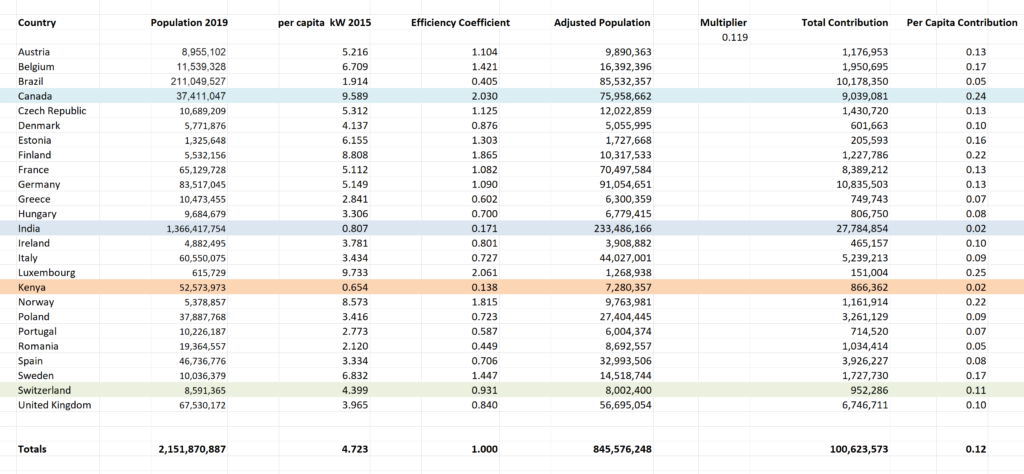GEEO – Greater Earth Energy Organization
A Space Solution to a Terrestrial Problem
Arthur R. Woods (*)
Introduction
Humanity is at a crossroads: it must decide if it prefers to live and prosper in an energy rich world or attempt to survive in an energy poor one. An approach to finding a viable solution to the imminent climate and energy emergencies confronting humanity and an analysis of the options currently available are urgently necessary. The fundamental causes of these interrelated emergencies are the many environmental and geopolitical issues associated with the continued use of fossil fuels added to the fact that continued reliance on fossil fuels is projected to become problematic and conflict prone in the coming decades. Thus, a sensible transition to a reliable, adequate and environmentally neutral alternative source of energy is imperative in order to preserve and sustain present civilization and to provide future generations with sufficient energy and hope for prosperity and peace.
Currently, 85% of world energy consumption comes from fossil fuels. The United Nations, many governments, scientific and environmental organizations have declared a Climate Emergency and are calling for net-zero CO2 emissions targets by the year 2050 in order to lessen the effects of CO2 induced global warming by divesting from the use of fossil fuels. This process assumes that terrestrial solutions will be adequate for addressing this crisis if intergovernmental measures can be implemented in time. However, upon close examination, no terrestrial energy option – nuclear, wind and solar photovoltaic – can be realistically scaled to achieve the desired goals to reach the CO2 targets and divesting from fossil fuels while adequately meeting the growing energy needs of humanity. In addition, fossil fuels are becoming gradually exhausted and will become uneconomical by mid-century. This represents an Energy Emergency that is even more serious. Policies that force society to retreat from the use of fossil fuels and policies that promote inadequate energy solutions will result in an energy poor world – a situation that may lead to global conflict and to the collapse of civilization.
A new perception of our planet called Greater Earth which is based on Earth’s true cosmic dimensions as defined by the laws of physics and celestial mechanics, describes a region with a diameter of 3 million kilometers through which passes 55,000 times more solar energy than what falls on the surface of the planet. The only feasible solution currently available to humanity for addressing the climate and energy emergencies is the “space energy option” which is based on a technological concept often referred to as Space-Based Solar Power (SBSP) which will harness the inexhaustible solar energy available in the region of Greater Earth to supply humanity with the abundant clean energy it will need in the future. The standard criticism of this technology since it was first introduced in 1973 has been its large scale and the initial costs. To address these concerns, an innovative plan called: “GEEO – the Greater Earth Energy Organization” is being proposed as a means to technically, economically and equitability to develop and implement the space energy option. Most people would prefer to live in an energy rich world rather than in an energy poor world. This applies not only to standards of living but also having sufficient energy to tackle other global problems such as restoring the environment, adapting to climate change, providing adequate clean water, ending poverty as well as providing real hope for a positive and peaceful future for all humanity.
The Energy Emergency
Data published in the BP Statistical Review of World Energy 2019 indicates that world energy consumption in 2018 was approximately 13,865 MTOE (million tons of oil equivalent) which is equivalent to 18.4 TW (terawatts) of electrical power. [1] This estimate was confirmed in the recently published World Energy Outlook 2019 by the International Energy Agency which set the total amount at 14,300 MTOE which, when converted to electrical power, is approximately 19 TW.[2] Using the BP report which also lists Primary Energy Consumption by fuel type – oil, natural gas, coal, nuclear energy, hydroelectricity and renewables, a breakdown of the 18.4 TW of total world energy consumption shows that 15.6 TW (85%) came from fossil fuels including oil, natural gas and coal, 0.8 TW (4%) from nuclear power, 1.3 TW (7%) from hydroelectricity and 0.75 TW (4%) came from wind and solar (PV) renewables. (Figures 1 & 2.)
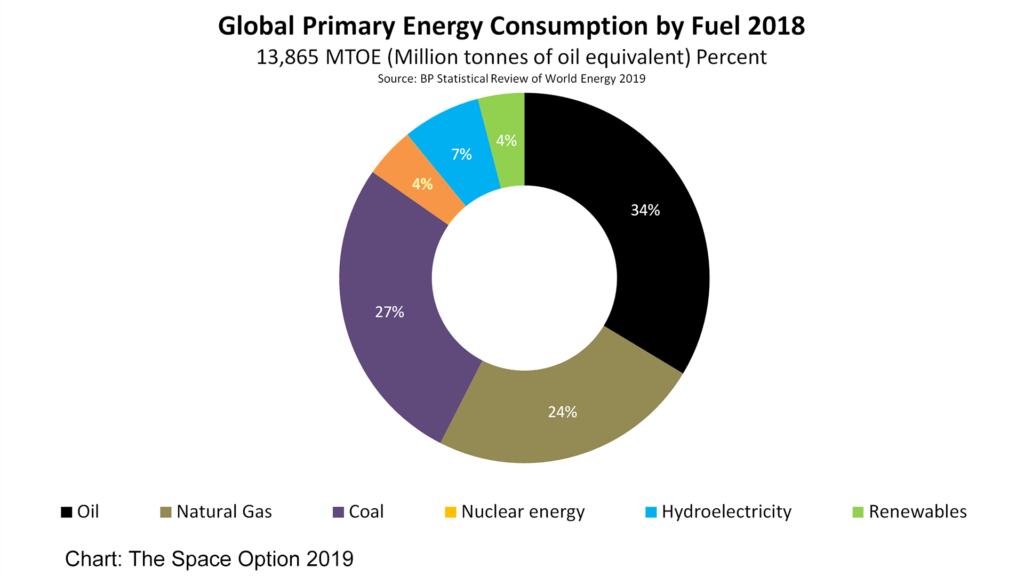
Figure 1. World energy consumption by fuel type and by percent.
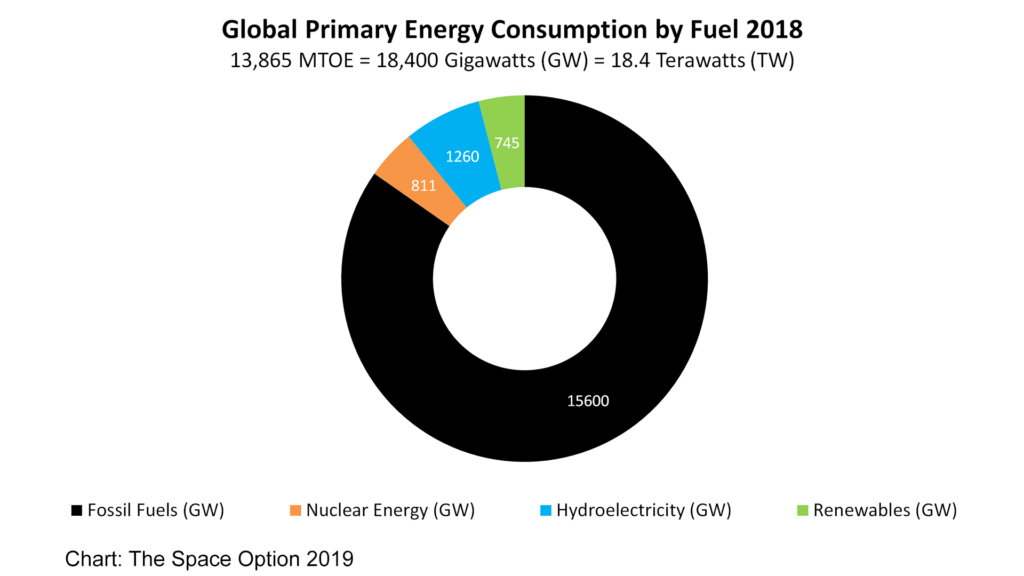
Figure 2. Global energy consumption by fuel converted to electrical power.
To illustrate what it would take to replace fossil fuels with an alternative terrestrial energy source, nuclear power can be used as an example. A typical nuclear power station generates about 1-GW of electricity and runs at 90% availability. Therefore, in order to replace current fossil fuel use of 15.6 TW with nuclear power, this would require the construction of up to 17,530 nuclear power plants generating 17.2 TW of power. On the average then, for the next 30 years, 572 new power plants would have to go on line each year – in other words, adding 1½ new 1-GW reactors each day. In 2018, world-wide nuclear power systems accounted for only 811 GW (4% of the total energy use) and, currently, building one nuclear power plant takes about 10 years. Furthermore, some estimates conclude that the uranium reserves may supply the currently-operating reactors only for some 90 years more. It is highly unlikely that this could be achieved due to the high costs, the long development times, public resistance, nuclear waste disposal issues, the lack of suitable locations with sufficient water and the fact that uranium supplies are finite are would not be adequate for this many new nuclear power stations. Worldwide, there are currently 449 nuclear power plants in operation.
As far as renewables are concerned, due the inherent intermittency and storage factors associated with wind and solar energy production, at least three times more electrical generating capacity from these sources must be installed to equal the output of nuclear power in the above example. This means that approximately 52 TW of wind and solar capacity would be needed to equal the energy provided by fossil fuels today. As both wind and solar installations require much surface area as well as optimal weather conditions in favorable locations, reaching this goal also appears unrealistic. Currently just 0.745 GW of renewables have been installed worldwide.
The above examples only concern replacing the energy derived from fossil fuels in 2018 as was reported in the BP report. As world population is expected to increase by 25% to 9.7 billion in the year 2050, it can be assumed that at least 25% more energy will be needed which would increase world energy demands to approximately 23 TW. Currently, almost 1 billion people are without access to energy, 3 billion lack access to clean cooking solutions, proper fuels for heating and are on the threshold of industrial development. [3] However, most energy organizations estimate that humanity’s 2050 energy needs will be at least 50% more than today or at least 28 TW, but probably even much more as the lesser developed nations increase their economic activities. Over the last decade worldwide energy consumption has increased at a rate of 1.5% per year and if this rate continues, then humanity would need at least 31 TW of energy in the year 2050. If distributed equally, this would provide a worldwide per capita energy consumption level of about 3 kW which is less than what most European nations on average currently consume. If energy efficiency measures are adopted worldwide and energy equally distributed this could be a realistic goal towards eventually creating an energy rich future.
As seen in Figure 3. below, estimates provided by the BP: World Reserves of Fossil Fuel, indicate that the remaining proven extractable reserves of fossil fuels are reaching critical levels. [4] As shown, at current rates of consumption, humanity will exhaust the proven reserves of crude oil in the year 2068, natural gas by the year 2070 and coal in the year 2151. This significantly adds to the urgency of finding a viable global energy solution and underscores the imminent Energy Emergency that humanity is facing.
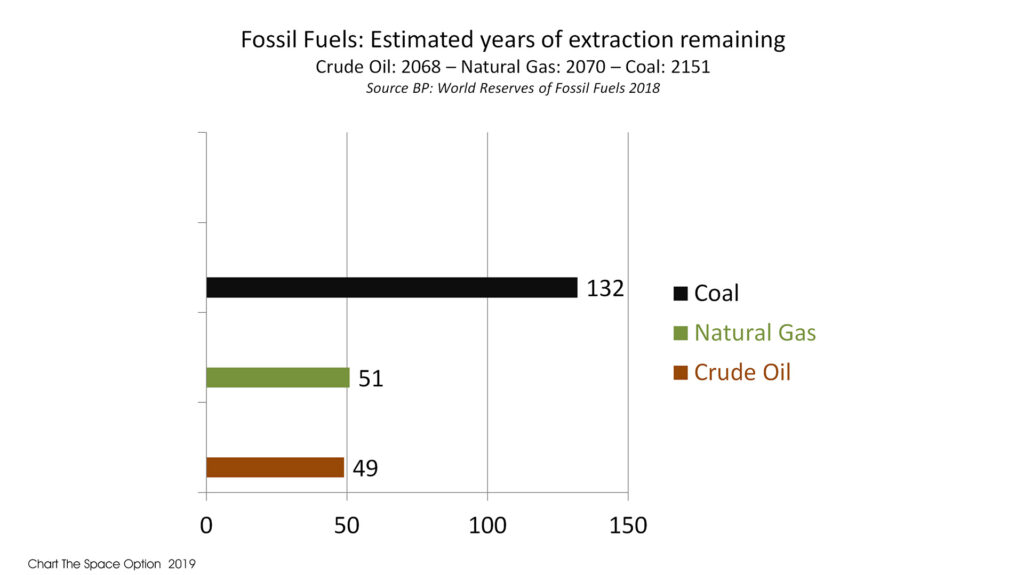
Figure 3. Estimated dates of fossil fuel exhaustion
For a more detailed analysis of the Energy Emergency please view: Space Energy Options for Addressing the Energy Dilemma and the Climate Emergency
The Climate Emergency
Due to the many assessments and reports issued since 1990 by the United Nation’s IPCC – Intergovernmental Panel on Climate Change – and the subsequent international commitment to address the climate issue achieved in the 2015 Paris Agreement on climate change which, as of March 2019 has now been signed by 187 countries, the world population has become increasingly alarmed that a period of global warming has commenced which may lead to environmental catastrophe by the end of this century. Numerous scientific studies have shown that this warming is caused by rising levels of CO2 in the atmosphere which is attributed to the continued dependence on the use of fossil fuels to satisfy most of humanity’s energy needs. A worldwide program to address an impending climate disruption has been incorporated into the United Nation’s Agenda 2030 program [5] including the Paris Agreement and the 17 Sustainable Development Goals as well as through a number of international conferences, [6] sub-organizations and public-private partnerships. Similar measures are also being promoted, developed and adopted by environmental and scientific organizations worldwide.[7] Many prominent people such as former US vice-president Al Gore, British natural historian and broadcaster David Attenborough and the young Swedish activist Greta Thunberg have brought the Climate Emergency to the world’s attention. [8]
As it is the Sun which warms the surface of Earth and drives the hydrologic cycle, it is the primary source of energy for the climate system which keeps Earth suitable for life. The sunspot cycle of the Sun also has much do with the changes in the climate and scientists report that the current long period of low sunspot activity may indicate that the Sun is entering a Solar Minimum which could lead to a severe cooling effect similar to the last Little Ice Age.[9] Solar activity which modulates the influx of galactic cosmic rays (high-speed particles that strike the Earth from space), has been shown to have a direct influence on cloud formation and has been correlated with warmer periods during high solar activity and cooling periods during low levels of solar activity.[10] Severe global cooling could result and this situation would probably be much worse for humanity than the predicted rise in global temperatures as this would directly affect food production and require additional energy for heating and maintaining all aspects of society. In either case, addressing the Climate Emergency will require massive amounts of clean energy production for a growing population to adapt and survive a severe warming or a severe cooling situation. [11] The Energy Emergency and the Climate Emergency are deeply interrelated as a new reliable and inexhaustible clean energy source must be developed to address both situations.
The Energy Market
To put this discussion into an economic context, the value of the world energy market is reflected in the consumption level of 13,865 MTOE (million tonnes of oil equivalent). Therefore, by converting the 13,865 MTOE (million tonnes of oil equivalent) into BOE (barrels of oil equivalent) this equals 99,035,714,285 BOE which enables an estimate of the global energy market based on the price of a barrel of oil. According to the BP Statistical Review of World Energy 2019 mentioned above, the average current production price (2018) of a barrel of oil was about US $70. If one adds refining, transportation and distribution costs this amount can be adjusted to $150/barrel. Thus, based on this estimate, the 2018, the consummation of 99,035,714,285 BOE had an estimated market value of US $ 14’855’357’142’750 or US $14.9 trillion dollars.
Using this information one can also make some simple projections based on current oil prices noting that, as fossil fuels becomes more difficult to produce this will surely impact the future price of this finite energy resource. Furthermore, as the world’s financial system is sensitive to the price of fossil fuels as well as to the role and value of the US dollar in the energy market; disruptions in this market will have major consequences for the world economy. The control of fossil fuels as an energy resource has been and will continue to be a major factor in geopolitical conflicts which also directly impacts the energy market. In addition, the proposed Carbon Taxes and Carbon Trading schemes to reduce the use of fossil fuels will also impact the price. Taking the above into account yet relying on the current situation, the following projections provide some useful insights into the anticipated 2050 energy market.
Year 2050 Market Estimates
With the population expected to increase from 7.7 billion to 9.7 billion in the year 2050, at current energy consumption and price levels the value of the energy market would automatically increase by at least 25% and the value to US $18.75 trillion. A 50% increase in energy consumption would equal approximately US $22.3 trillion. A 1.5 % average yearly increase in consumption would require 23,002 MTOE which results in an energy market of US $24.65 trillion. Thus, based on the current price of oil, calculated in today’s dollars without any major disruptions or inflation, the projected the value of the energy market in the year 2050 will be between 19 and 25 trillion US dollars. However, considering inflation and all of the factors mentioned above, this amount will probably be much more.
For a more detailed analysis of the Energy Market please also view: The Energy Emergency and the Space Option
Greater Earth
Today, most people are comfortable with the image of Earth as defined by the edges of its atmosphere which has become a powerful symbol of our times representing the environmental movements, the globalization of our diverse cultures and economies, and an understanding about the interdependence and interconnectedness of our climate and ecology. (Figure 4.) This is a 20th century view of Earth and human affairs are conducted accordingly. Not very different than our early ancestors, most of today’s world leaders and probably most people alive instinctively assume that whatever humanity’s fate in the years ahead, that fate will be ultimately decided and enacted on the surface of planet Earth and not anywhere else in the cosmos. Instinctively, Earth problems must surely have Earth solutions. In the case of the energy and climate emergencies, at the moment humanity is consequently only focusing on finding a terrestrial solution to what may actually be an unsolvable problem.
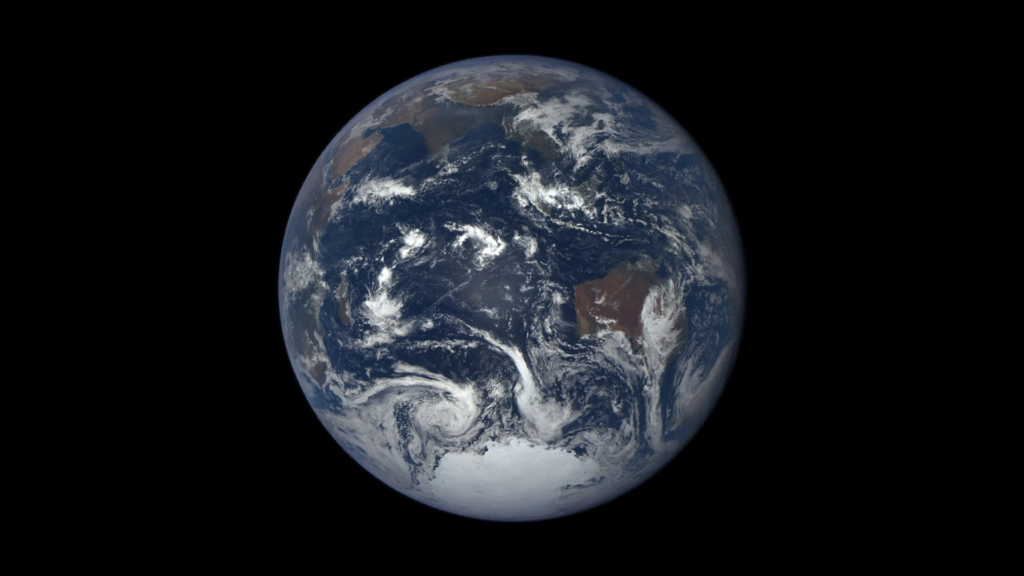 Figure 4. Earth captured by NASA’s EPIC camera on the Deep Space Climate Observatory (DSCOVR) satellite located 1.5 million kilometers distance from Earth at Lagrange point L1
Figure 4. Earth captured by NASA’s EPIC camera on the Deep Space Climate Observatory (DSCOVR) satellite located 1.5 million kilometers distance from Earth at Lagrange point L1
However, this perception of our home planet defined by its atmosphere is outdated and constraining. To address the imminent energy and climate emergencies a new perception of planet Earth based on its true cosmic dimensions – a perception called Greater Earth needs to emerge and be embraced.
In the 20th century humans began to investigate ways to penetrate the atmosphere. Today a communications apparatus installed beyond the atmosphere permits most people on Earth to remain in constant touch with each other from any place on the planet. Orbital outposts are providing the information to enable human beings to adapt to the changing environment. Scientific instruments placed in this area are exploring the depths of the cosmos and investigating the state of the climate on the planet below. National security systems have placed monitoring devices that track developments and movements of opponents making surprise attacks less likely. Indeed, the functioning of contemporary society is totally dependent on these technological resources orbiting the Earth and without them modern civilization would no longer function.
In just over 60 years, these space activities have effectively expanded the physical territory of planet Earth from its solid dimensions of 12,756 kilometers to a diameter of approximately 84,328 kilometers. As the 21st century unfolds, humanity finds that it needs more room and more resources to sustain its population, to maintain its drive for further development and to address the imminent environmental and energy issues it currently faces. The finite planetary resources that have contributed to reaching its present state of development are being strained to unsustainable levels and their uncontrolled use within the biosphere is resulting in severe environmental and ecological consequences. As it is unequipped to occupy and transform a neighboring planet to meet its growing needs, humanity’s next logical step will be to discover and inhabit the last reaches of its own planet – to expand its activities to Earth’s true boundaries as defined by the laws of physics.
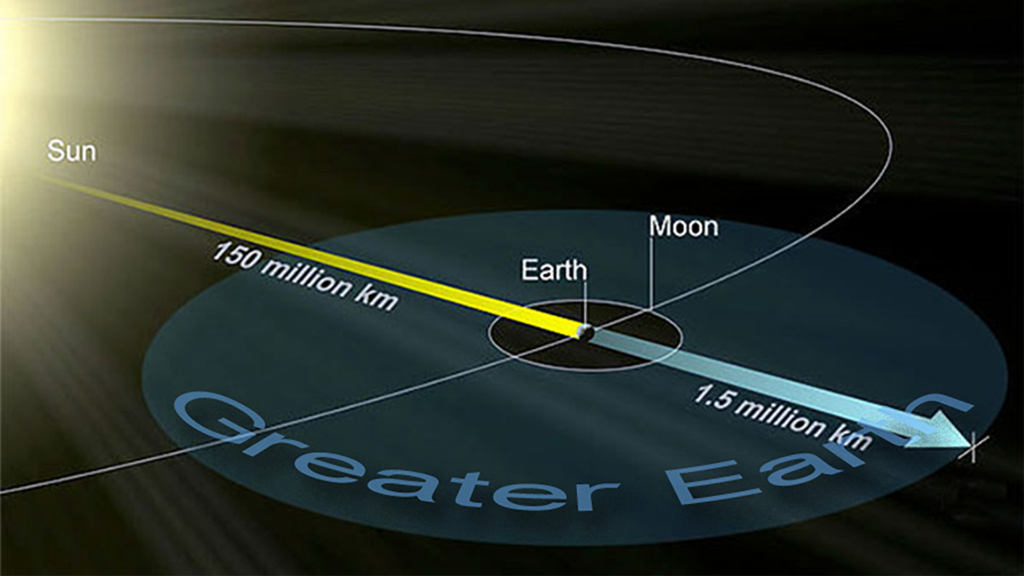
Figure 5. Diagram of Greater Earth
All celestial bodies of significant concentrated mass exert a field of gravitational attraction around their cores which extends to the point of tangential intersection with other celestial bodies. Earth’s gravitational influence extends 1.5 million kilometers in all directions from its center where it meets the gravitational influence of the Sun. (Figure 5.) This sphere has 13 million times the volume of the physical Earth and through it, passes some more than 55,000 times the amount of solar power which is available on the surface of the planet. In addition to energy, within this sphere of 3 million kilometers are enormous amounts of other resources, including the Moon and occasional passing asteroids. Like the territorial waters surrounding nations on Earth, these resources naturally belong to our planet and should be used for the ultimate benefit of humanity and all life which has originated here. As it has throughout its history, humanity must understand and seek nourishment from its home planet and, in order to do so, it must now once again refine its perception of the planet in order to recognize and embrace the perception of a greater, richer and more sustainable Greater Earth.
The Greater Earth System
To truly embrace this new perception of our planet, one has to also realize that Greater Earth is not only a region defined by celestial mechanics and the laws of physics but it also a dynamic system that may have enabled life on Earth to appear and to thrive. The region outside Earth’s atmosphere and extending out to just beyond the Moon’s orbit, including the Earth-Moon Lagrangian points, is referred to as cislunar space – a region which contains approximately 95% of all humanity’s space assets. Geolunar space is the region from the Moon to the Earth-Sun Lagrangian points located 1.5 million km outwards where the Earth’s gravitational influence is balanced by that of the Sun and this marks the outer boundary of Greater Earth. This is 1/100th of the average distance between the Earth and the Sun which is also used as the AU Astronomical Unit, recently set by the International Astronomical Union to be precisely 149,597,870,700 km. Interestingly, the outer reaches of the Solar System, the Oort Cloud which is approximately 15 trillion km from the Sun.
The Earth was formed approximately 4.54 billion years ago by accretion over a period of 10-20 million years as part of the circumstellar disk that grew out from the Sun. Earth orbits around the Sun in 365.26 days, a period known as an Earth year. During this time, Earth rotates on its axis about 366.26 times and as this axis is tilted with respect to its orbital plane. Earth’s initial rotation was a vestige of the original angular momentum of the cloud of dust, rocks, and gas that coalesced to form the Solar System.
The Earth’s moon, which has the Latin name Luna, is thought to have formed approximately 4.5 billion years ago from the debris left over after a giant impact between proto-Earth and a Mars-sized body called Theia. This impact which formed the Moon also reset Earth’s primordial rotation. Regardless of the speed and tilt of Earth’s rotation before the impact, it would have experienced a day approximately five hours long resulting in very high winds on the surface which would have been unsuitable for the emergence of life. Due to the gravitational influence of the Sun and the Moon, tidal effects have since slowed Earth’s rotational period to its current 24 hours.The Moon also has a stabilizing effect on Earth’s obliquity – axial tilt – which is responsible for the four seasons and which has enabled life to exist in all regions of the planet. Thus, the the Sun, the Moon and the Earth can be viewed as an interdependent system in which the Earth’s gravity keeps the Moon in orbit and the Sun’s and the Moon’s gravitational influence on the Earth produces the ocean tides, earth or body tides, the four seasons, and the slight lengthening of the day as the Moon influences Earth’s rotation period and axial tilt. The Moon and the Sun appear to viewers on Earth to be the same size in the sky which is obvious when there is a total eclipse of the Sun. This is due to fact that the Moon is 400th the size of the Sun and is 400 times closer to the Earth than the Sun.
The Sun’s gravitational influence keeps the Earth in its advantageous location referred to as the “Goldilocks Zone” where the temperature is just right – not too hot and not too cold – for liquid water to exist on a planet which is considered optimal for life to appeared and thrive. The sunlight from the Sun that reaches the Earth’s surface warms the planet, drives the hydrologic cycle and is the primary source of energy for the climate system which keeps Earth suitable for life. Solar activity which modulates the influx of galactic cosmic rays (high-speed particles that strike the Earth from space), has been shown to have a direct influence on cloud formation and has been correlated with warmer periods during high solar activity and cooling periods during low levels of solar activity. Thus, once water arrived on Earth, the Sun’s energy, its solar activity cycles and its gravitational influence on both the Earth and the Moon have created a complex, interactive and dynamic system that has allowed for life to emerge and to evolve on Earth – a system that is surely rare if not unique in our galaxy and in the universe as far as we now know.
The Space Energy Option
As some 55,000 times the amount of solar power which is available on the surface of Earth passes through the region of Greater Earth, one only has to change our previous perception of our planet and look beyond the atmosphere to find the solution the terrestrial energy and climate problems. Yet, in current discussions about transiting from fossil fuels to some other alternative energy source, it is generally assumed that only terrestrial renewables such as wind and solar will provide the necessary energy once government mandated commitments to energy availability and CO2 reduction targets are established and enforced. It is therefore surprising that energy from space, generally referred to as Space-Based Solar Power (SBSP), a technologically feasible idea that was introduced as the Solar Power Satellite by Peter Glaser in 1968 and patented in 1973, is rarely considered or even discussed as a possible alternative to terrestrial energy sources when discussing possible solutions to the climate emergency.[12] The standard criticism of harnessing energy in space for use on Earth has been the initial cost to implement any space power system usually associated with the high price of launching mass into orbit. However, when considered in the context of the imminent climate and energy emergencies, and when viewed in the context of the worldwide market for energy, this criticism should have lesser relevance as terrestrial energy alternatives prove to be insufficient, impractical, uneconomic or undesirable and the magnitude of these two interrelated emergencies becomes apparent.
Since Peter Glaser’s published concept, a number of studies have described the feasibility of supplying Earth with solar power from space. The largest study was “Satellite Power System Concept Development and Evaluation Program” conducted by the United States Department of Energy (DOE) and NASA from 1977 to 1981 at a cost of $19.7 million which came to the conclusion that Space Solar Power (SPS) relying on large reusable rockets and automated assembly systems in orbit was technically feasible. However, the DOE, influenced by its preference for nuclear power and the related energy lobbies, canceled any further work on the project. The most recent study was conducted by the International Academy of Astronautics (IAA) [13] in 2011 which described how a SPS system located in Earth orbit would use the latest space technologies and be built by robots out of modular components – a concept that has both economic and maintenance advantages. Recent advances in reusable launch systems increase the feasibility of developing a space energy option.
There are several technological approaches to harnessing energy in space. These range from building the power satellites on Earth and placing these in low, middle or geostationary orbits or using lunar materials to construct the solar power satellites on the Moon for placement in Earth orbit or even directly transmitting the energy to Earth from the Moon. This lunar approach which is called Lunar Solar Power (LSP) that was originally introduced by David Criswell [14], would significantly reduce the cost of transporting massive tons of material from the surface of Earth into space which, due to the high launch costs, has been the biggest obstacle to the development of any space power system. Lastly, if nuclear fusion reactors ever become operationally feasible, eventually Helium-3 which is rare on Earth could be mined in sufficient quantities on the Moon for fusion reactors on Earth.
In addition to the above mentioned studies, there are several books that describe in detail the various space power technologies and approaches for harvesting energy in space for meeting humanity’s energy needs on Earth. These include:
- Return to the Moon by Harrison H. Schmitt (Helium-3) (2007) [ Amazon ]
- Energy Crisis: Solution from Space by Ralph Nansen (2009) [ Amazon ]
- Solar Power Satellites by Don M. Flournoy (2011) [ Amazon ]
- Sun Power: The Global Solution for the Coming Energy Crisis by Ralph Nansen (2012) [ Amazon ]
- Electric Space: Space-based Solar Power Technologies & Applications by Danny Jones and Ali Baghchehsara (2014) [ Amazon ]
- The Case for Space Solar Power by John Mankins (2014) [ Amazon ]
- Astroelectricity by Michael Snead (2019) [ Amazon ]
Although the engineering and logistical challenges would be formidable, except for the case of Helium-3 fusion power, no new technology needs to be invented and no scientific breakthroughs are necessary for the SBSP/LSP approaches. The generation of electrical power in space has been used for decades on spacecraft and the transmission of power via microwaves in space has been demonstrated. Additional research is needed to control and direct these low-intensity beams over the required distances of space. The logistics of establishing and supplying a lunar base community – though a very large endeavor – is comparable to similar large scale engineering projects that have been accomplished on Earth.
Addressing the Energy and Climate Emergencies in an environmentally neutral manner is no small task. On the one hand, there is the United Nation’s proposed “Agenda 2030 Option”[15] to transform industrial society by implementing regulated terrestrial solutions to Earth problems in order to cope with an increasingly energy poor and environmentally stressed world – a situation that could unfortunately eventually lead to an energy poor world resulting in global conflict as terrestrial energy resources prove to be insufficient. Or, there is the “Space Option”[16] which is to harness the inexhaustible resources of space to meet humanity’s present and future needs on Earth – of which energy is the most important – which could optimistically lead to universal peace and global prosperity and eventually, to the expansion of human civilization beyond the home planet. Most people would probably agree that it would be preferable to live in an energy rich world rather than in an energy poor world. This applies not only to maintaining standards of living in the developed countries but also to having sufficient energy to tackle other global problems such as restoring the environment, adapting to climate change, maintaining independent and free societies, ending poverty as well as providing hope for a positive future for all humanity.
GEEO – Greater Earth Energy Organization
Before the Industrial Revolution, humanity was dependent on the limited flow of solar energy captured in living plants for subsistence needs such as food, fuel, and shelter. Since the beginning of the industrial age fossil fuels have been used as sources of energy starting with the widespread use of coal in the 1800’s followed by the discovery of oil in 1849 and its use in internal combustion engines. Subsequently, contemporary industrial society has been built largely on petroleum resources. Life expectancy tripled and per capita income increased 11 fold. Fossil fuel use and the consequent anthropogenic emissions of carbon dioxide (CO2) also have greatly expanded the global food supply. Fertilizer derived from natural gas has increased agricultural productivity by 40-60 percent. Synthetic fibers derived from fossil fuels now account for 60 percent of all fibers. Basic materials such as plastic, vinyl, and fiberglass constitute the raw material used in thousands of products in daily use. Typically, fossil fuels can be characterized as being energy dense, abundant, versatile, reliable, portable and affordable.[17] However, environmental issues, geopolitical conflicts and the declining EROI (energy return on investment) due to the estimated scarcity of easily obtainable fossil fuels indicates a soon transition from these carbon fuels to a newer, cleaner and inexhaustible energy resource will be necessary for maintaining civilization and providing a means for future societal development.
As the United Nations, many governments, organizations and energy companies are currently focusing on how to deal with global warming through restrictions on the use of fossil fuels while promoting inadequate terrestrial renewable energy resources as the only replacement, a parallel initiative to achieve energy sufficiency and fossil fuel independence through the development of the space energy option is seriously needed. Due to the scope and magnitude of the energy and climate emergencies, such an initiative would have to become under the auspices of a global organization as well; such as the proposed Greater Earth Energy Organization (GEEO).
The goals of the GEEO are to provide the entire world with an inexhaustible supply of environmentally clean energy in an equitable, apolitical and socially just manner. The GEEO would be set up as a democratic international organization of nations independent of any other international organization or corporate influence. There two precedents for this type of international space related organization. The first is INTELSAT (1964-2001) – an intergovernmental consortium owning and managing a constellation of communication satellites before it became privatized in 2001. The second is the European Space Agency (ESA) – an intergovernmental organization of 22 member nations and 9 associate members dedicated to the exploration of space founded in 1975. It is interesting to note that not all member countries of the European Union are members of ESA and not all ESA member states are members of the European Union.
In the case of INTELSAT, the financing was shared among the member participants’ so called “investment share” that was strictly proportional to each member’s use of the system which was determined on an annual basis. [18] ESA has two budgetary categories: “Mandatory” which all member contributions are based on a scale related to their Gross National Product and “Optional” where members can optionally participate in special programs. From its beginning, ESA has applied a principle of “fair return” in its industrial procurement policy of geographical distribution.[19] Simply stated this is based on the ratio between the share of the weighted value of contracts a member country receives and the country’s contributions paid to ESA. This percentage of a member’s contribution is called the “industrial return coefficient”. For example, with a coefficient of 98% a member country can expect to receive 98% of its annual contribution in the value of contracts placed with its local industries. This process is constantly evolving and each budgetary process must look at the needs and goals of the organization so determine how this process can be optimally applied to a system involving contractors and sub-contractors.
Using these two organizations as examples and inspiration of the kind of international organization needed, the GEEO will be set up as an international consortium of nation states. Each member state will become a member of the General Assembly of Parties (GAP) with an equal vote in deciding the strategic organizational policies and the budget plans. An organizational infrastructure will be created to manage the GEEO operations.
To achieve as much as possible a 100% fair and equal participatory plan reflecting the energy procurement and development process, each member’s contribution to GEEO will be determined by an efficiency coefficient that is based on its population and its per capita energy consummation. A country with a higher per capita consumption of energy and a small population will contribute correspondingly more to the GEEO budget than a country with a large population and a lower per capita energy consumption level on a per capita basis. As increased energy use is correlated with a country’s level of economic development, this formula should encourage already developed countries consuming higher levels of energy to become more energy efficient while stimulating lesser developed countries with low per capita energy use to intentionally increase their level of energy use in order to further their economic development.
As with the ESA concept of fair return and geographical distribution, an equal percentage of a country’s contribution to GEEO will be returned to the country through contacts that are placed with its local industries and organizations. The following example illustrates how this might function. The GAP meets and determines its immediate development goals and associates a corresponding budget to achieve these goals. With a larger number of participating member countries the budget can be larger while the per country contribution smaller. Figure 6 shows the funding breakdown of the ESA budget for 2019. [20]
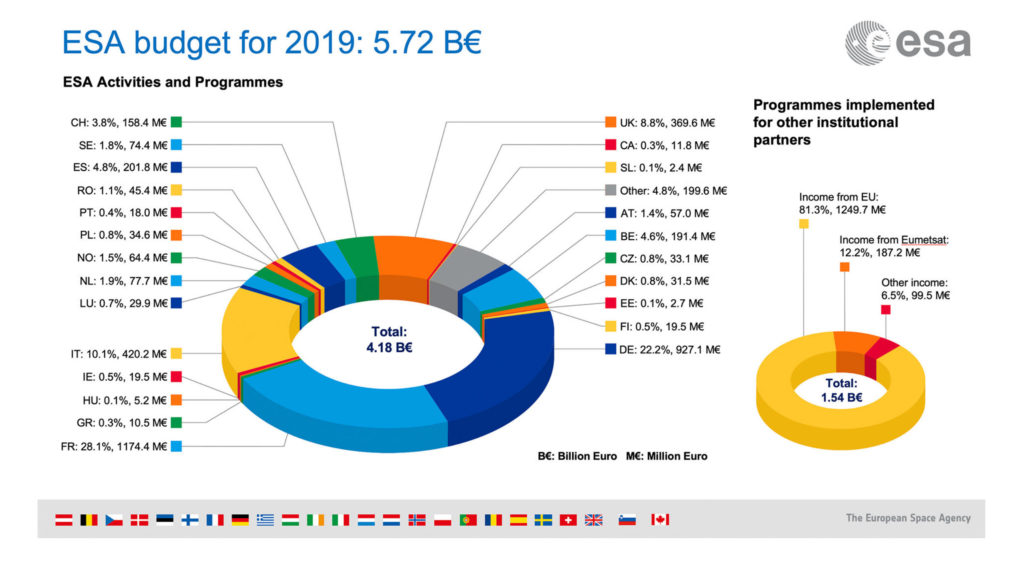 Figure 6. Breakdown of the ESA budget for 2019
Figure 6. Breakdown of the ESA budget for 2019
The examples below are based on 25 member nations from different geographical regions representing just over 2 billion people. China, the United States and Japan have not been included as they have already considered their own space energy programs although these countries may find that the GEEO approach is more economical. As the start-up phase the activities of the GEEO will primarily consist of organizational matters and research and development, the initial budget in the first example (Figure 7.) has been set at 100 million. Note: the actual currency to be used for accounting purposes is discussed below.
Figure 7. Using the Efficiency Coefficient to calculate yearly contributions to a budget of 100 million.
(Click on image to enlarge)
As can be seen in the four highlighted examples above, of a yearly budget of 100 million set by the GAP, Canada with its population of 37.4 million would contribute a total of about 9 million to the budget which equals .24 cents per person. India’s contribution would be about 28 million which is .02 cents per person based on its population of 1.4 billion. Kenya, with a population of 52.6 million would also pay just .02 per person or a total of 866 thousand. Comparably, Switzerland would pay 952 thousand based on its population of 8.6 million which works out to .11 cents per Swiss individual. As determined by the GEEO’s GAP, a set percentage of these national contributions would be returned to each member nation in the form of contracts to their local industries, organizations and educational institutions.
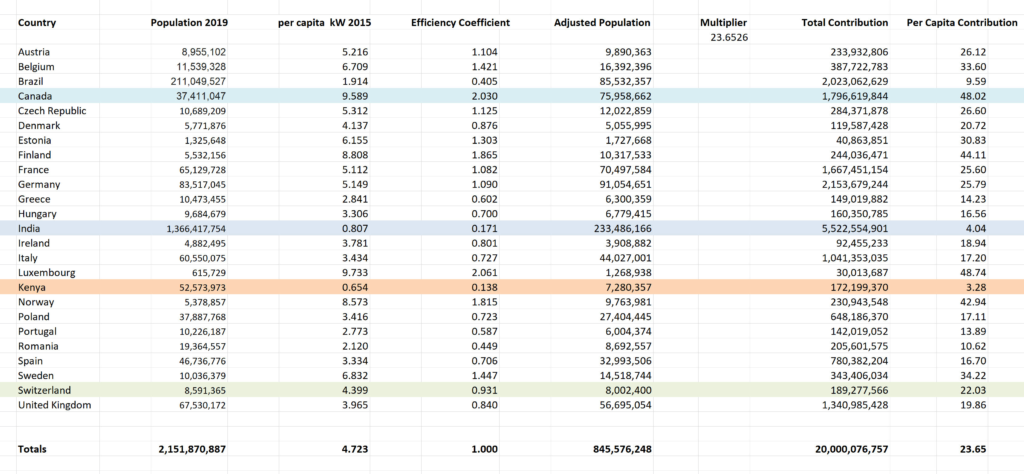 Figure 8. Using the Efficiency Coefficient to calculate yearly contributions to a budget of 20 billion
Figure 8. Using the Efficiency Coefficient to calculate yearly contributions to a budget of 20 billion
(Click on image to enlarge).
After several years of research and development more funds will be needed for technological development and hardware procurement. Using the 2019 NASA budget of approximately $20 billion and the 2019 ESA budget of approximately $6.3 billion (€5.72 billion) as an example, a phase B budget could hypothetically be set at 20 billion. (Figure 8.) The average contribution per person from the 25 GEEO member nations would be approximately 24 accounting units. In this budgetary case, Canada with its population of 37.4 million would contribute a total of about 1.8 billion to the budget, India’s contribution would be about 5.6 billion, Kenya would pay 173 million and Switzerland about 190 million. In terms of US dollars or Euros, Switzerland’s contribution to ESA in 2019 was US $176 million or €159 million.
GEAU – the Greater Earth Accounting Unit
As the GEEO is an international consortium of nations and each country has its own economy and currency, an internal accounting unit will need to be established that can be equitably used among the members for setting the yearly budget and for accounting purposes. This enables a fair and just accounting practice and avoids the geopolitical use of any currency as an instrument of monetary policy, speculation and/or economic warfare.
Before the Euro became an established currency in the EU, ESA used a similar “accounting unit” approach among its members. Therefore, GEEO will establish the GEAU as the Greater Earth Accounting Unit for its budgetary and accounting purposes. Coincidentally GEAU is pronounced the same as GEEO. In the initial phases of development, the GEAU will be associated with or “backed by” to a terrestrial commodity such as a precious metal. Gold has been traditionally used in this function and a number of nations including Russia, China and India are currently stockpiling gold to value back their currencies and as a way to decouple their currency from the so called “petro dollar” and the US dollar as the world’s reserve currency which has given the United States many economic advantages that other countries do not have.
In this example silver will be used as a precious metal commodity for backing the GEAU in its initial stages. Silver is more plentiful than gold and is also widely used as an industrial material. A more environmentally benign commodity or a combination of precious metals may be used, but in the initial phase the GEAU needs to have a worldwide recognized value and precious metals have an historical role. At current retail prices one kilogram of silver costs approximately US $600. Thus, for this example and for accounting purposes the value of one GEAU could be correlated to 1 gram of silver, 10 GEAUs to 10 grams of silver and 1000 GEAUs would be the equivalent of 1 kilogram of silver. Thus, US $10 billion would equal approximately 16.7 billion GEAU. Therefore, as a country’s yearly contribution to GEEO would be in calculated in GEAUs, a country would have to possess an equivalent verifiable amount of silver in its own national reserves.
This would not be a cumulative but a progressive reserve as the country will receive a large percentage of its yearly contribution via the geographical industrial return policy and its GEAU contribution would be assessed on a yearly basis. In this case, a country may have to increase its silver reserves to meet an increasing budgetary requirement for the subsequent year. For the more developed countries this should not pose a problem. For the lesser developed countries this growing reserve of silver would likely add value to its own currency.
Once the GEEO starts to produce and distribute energy the intrinsic value of the GEAU would then be based on the value of the power it is producing and the terrestrial commodity reserves of silver which served to back the original contributions could be used by the nations for other purposes. Simply stated, the member nations of GEEO agree to use the GEAU for all of its accounting purposes and the nations agree that their yearly contribution in the form of GEAUs will be backed by a commodity such as silver. Once electrical power is being generated and distributed, the value of the GEAU becomes pegged to the value of the energy it is distributing or selling. An added advantage to this concept is when the GEEO must purchase materials or services outside of its member consortium. For these transactions, the GEAU which is pegged to the price of silver could conceivably be converted into whatever currency necessary for this purpose.
As all the GEEO members have all mutually financed and developed the space energy option the electrical power they will receive will be based on the cost of operation and maintenance of the space power system and will be calculated in GEAUs. Similar to how hydro-electrical systems function today as there is no cost added for the fuel. Likewise, space power systems once installed should have very long energy producing lifetimes. Nuclear power and fossil fuel powered electrical generation systems on the other hand, must also add the price of fuel to their market price.
In the first phase of the GEEO any nation may join by simply agreeing to pay the yearly contribution and participating in the GAP. When the research and development phase has been completed and implementation of the space power system has commenced, the GAP may require an adjusted initial fee for new nations to join the GEEO. Once electrical power is being produced and distributed, excess power may be sold to non-members at whatever market value that has been determined by the GEEO. This approach should create an incentive for many nations to join the GEEO as soon as possible.
The technology development program would focus on finding efficiencies by using existing facilities and through the mass production of standardized elements such as the launch system and the space power components using automated manufacturing whenever possible. Robotic systems would be deployed to assist the construction of the space power systems in orbit. In the case of using of lunar materials, a human presence would also likely be required. Fortunately, a number of nations are currently developing plans to set up facilities on the Moon.
If all the nations of the world would agree to join the GEEO in order to address the climate and energy emergencies with commitment and enthusiasm, within 10 years (which is less time than the US needed to complete the Apollo program) the world could conceivably begin to receive environmentally clean energy in inexhaustible quantities and the space energy option would become economically self-sufficient. As such, by the end of the century, energy would become as ubiquitous as air and water for future generations.
The Geopolitical and Legal Dimensions
As an international consortium of nations, the GEEO should be incorporated as a not-for-profit organization. The main advantage to having such a structure would be to avoid conflict and competition between nations and to provide a transparent process for the development and eventual distribution of this new energy resource. Ideally, this organization should be based in a neutral country with a credible regulatory framework. Switzerland represents such a country and international organizations such as the IOC – the International Olympic Committee (in French, Comité International Olympique CIO) and FIFA (Fédération Internationale de Football Association) have their headquarters in Switzerland and both are registered as “associations” which, under Swiss law, allows them to have a tax free status if requested. Both organizations manage budgets amounting to billions of dollars.
The legal framework for the eventual use of extraterrestrial resources rests with the Outer Space Treaty (OST) which forms the basis of international space law. [21] The OST entered into force on October 10, 1967 and, as of June 2019, 109 nations are parties to the treaty. The Outer Space Treaty provides the basic framework on international space law, including the following principles:
- the exploration and use of outer space shall be carried out for the benefit and in the interests of all countries and shall be the province of all mankind;
- outer space shall be free for exploration and use by all States;
- outer space is not subject to national appropriation by claim of sovereignty, by means of use or occupation, or by any other means;
- States shall not place nuclear weapons or other weapons of mass destruction in orbit or on celestial bodies or station them in outer space in any other manner;
- the Moon and other celestial bodies shall be used exclusively for peaceful purposes;
- astronauts shall be regarded as the envoys of mankind;
- States shall be responsible for national space activities whether carried out by governmental or non-governmental entities;
- States shall be liable for damage caused by their space objects; and
- States shall avoid harmful contamination of space and celestial bodies.
With regards to the development of the space energy option several articles are of particular importance which further gives credence to having an international approach.
Article I: The exploration and use of outer space, including the Moon and other celestial bodies, shall be carried out for the benefit and in the interests of all countries, irrespective of their degree of economic or scientific development, and shall be the province of all mankind. Outer space, including the Moon and other celestial bodies, shall be free for exploration and use by all States without discrimination of any kind, on a basis of equality and in accordance with international law, and there shall be free access to all areas of celestial bodies.
Article II: Outer space, including the Moon and other celestial bodies, is not subject to national appropriation by claim of sovereignty, by means of use or occupation, or by any other means.
Article III: States Parties to the Treaty shall carry on activities in the exploration and use of outer space, including the Moon and other celestial bodies, in accordance with international law, including the Charter of the United Nations, in the interest of maintaining international peace and security and promoting international co-operation and understanding.
Article IV: The Moon and other celestial bodies shall be used by all States Parties to the Treaty exclusively for peaceful purposes.
Article VI: States Parties to the Treaty shall bear international responsibility for national activities in outer space, including the Moon and other celestial bodies, whether such activities are carried on by governmental agencies or by non-governmental entities, and for assuring that national activities are carried out in conformity with the provisions set forth in the present Treaty. The activities of non-governmental entities in outer space, including the Moon and other celestial bodies, shall require authorization and continuing supervision by the appropriate State Party to the Treaty. When activities are carried on in outer space, including the Moon and other celestial bodies, by an international organization, responsibility for compliance with this Treaty shall be borne both by the international organization and by the States Parties to the Treaty participating in such organization.
Article IX: In the exploration and use of outer space, including the Moon and other celestial bodies, States Parties to the Treaty shall be guided by the principle of co-operation and mutual assistance and shall conduct all their activities in outer space, including the Moon and other celestial bodies, with due regard to the corresponding interests of all other States Parties to the Treaty.
Article XIII: Any practical questions arising in connection with activities carried on by international intergovernmental organizations in the exploration and use of outer space, including the Moon and other celestial bodies, shall be resolved by the States Parties to the Treaty either with the appropriate international organization or with one or more States members of that international organization, which are Parties to this Treaty.
To adhere to the provisions of the OST, and to avoid any potential conflicts, it would advantageous and indeed practical if all the current signatories would become members of the GEEO.
Conclusions
The Energy and Climate Emergencies are interrelated as having access to plentiful clean energy is the key to addressing either situation. Easily obtainable fossil fuels will reach critical levels by mid-century. Terrestrial alternative energy sources including nuclear, wind and ground solar cannot be realistically scaled to replace fossil fuels at present or at future consumption levels. The only technologically near term alternative currently available to humanity is the space energy option which is to harvest energy in space for meeting humanity’s energy needs on Earth.
Although engineering will be a substantial challenge, no technological or scientific breakthroughs are necessary for developing the space energy option. The standard criticism for deploying a space power system has been the initial cost, especially the cost of launching massive amounts of mass into orbit. Mass producing re-usable launch systems and automatizing the manufacturing process of the space power systems will bring down these costs and the eventual the use of lunar materials could further reduce costs.
Projected world energy demand based on estimated population projections will approach 31 TW of power annually. Distributed equally, this would be a per capita energy consumption of 3 kW which could lead to worldwide prosperity. The estimated value of this energy market calculated in today’s dollars will grow to at least US $20-25 trillion but probably much more.
The creation of an international collaborative organization such as GEEO – the Greater Earth Energy Organization using an internal accounting unit such as the GEAU could, in principle, practically “bootstrap” the development and deployment of the space energy option whereas the only financial “risk” would be backing the GEAU with a commodity such as silver until the moment when power from space systems becomes widely available to the GEEO members and to the entire world. At this point the system should become economically self-sufficient. To insure transparency and accountability, the GEEO should be incorporated as a not-for-profit organization under the laws of a neutral country with a credible regulatory framework.
An intergovernmental organization such as GEEO would automatically adhere to the provisions of the Outer Space Treaty and avoid possible international legal obstacles that could evolve in the case of a single nation or corporate entity. Implementing the space energy option, if successful and timely, could diffuse current and future geopolitical conflicts over the control of the remaining finite fossil fuels. Terrestrial alternative energy sources could continue to be developed and deployed intelligently to ease the energy transition to a space-based option but their overall energy production potential and their environmental impact will need to be realistically evaluated.
Most people would agree that it would be preferable to live in an energy rich world rather than in an energy poor world. This applies not only to our standard of living but also having sufficient energy to tackle other global problems such as restoring the environment, adapting to climate change, providing adequate clean water, ending poverty as well as providing hope for a positive and peaceful future for all humanity. If, as shown in this article, the existing alternative terrestrial energy resources cannot be realistically scaled to meet humanity’s future energy needs as a replacement for fossil fuels, then neither will regulatory frameworks, taxes on CO2, carbon trading schemes, nor new business models to change society’s energy habits adequately address the impending Climate and Energy Emergencies. The time to solve these global emergencies is now, creating the GEEO and implementing the space energy option is a realistic and pragmatic way to do so. As it is an “option” it should be evaluated and compared with all other energy options available to humanity.
(*) Arthur R. Woods is an independent researcher and astronautical artist based in Switzerland with two art projects successfully flown on the Mir space station. He is co-founder with Marco C. Bernasconi of The Space Option concept. He is member of the International Academy of Astronautics.
The GEEO website is under construction at: https://geeo.earth
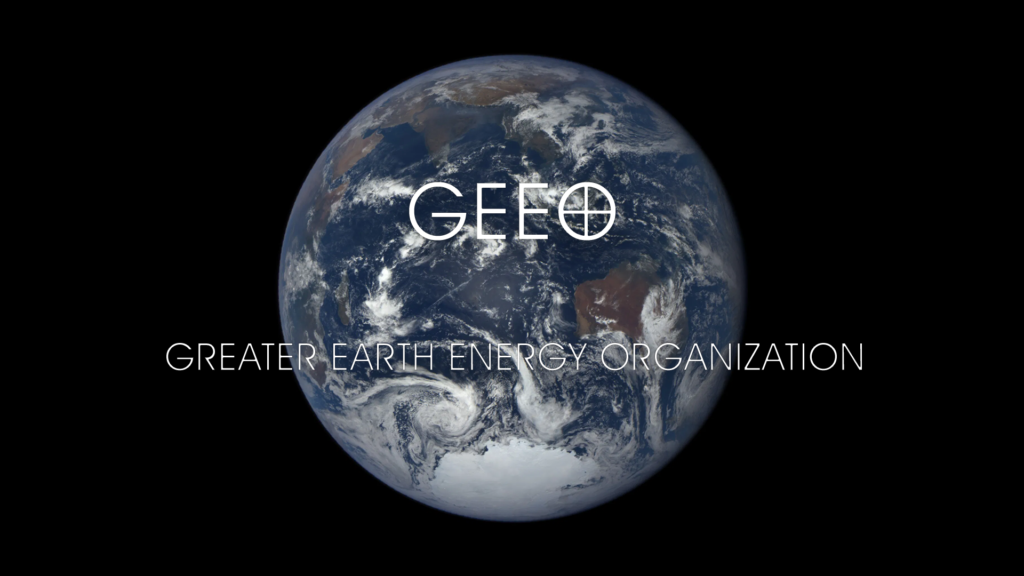
References:
[1] BP Statistical Review of World Energy 2019 (Accessed 19.11.2019) – https://www.bp.com/content/dam/bp/business-sites/en/global/corporate/pdfs/energy-economics/statistical-review/bp-stats-review-2019-full-report.pdf
[2] IEA, World Energy Report 2019, Launch Presentation, Page 4, https://www.iea.org/media/publications/weo/WEO2019-Launch-Presentation.PDF (N/A)
https://thespaceoption.com/PDF/IEA-World_Energy_Outlook_2019_Launch_Presentation.pdf
[3] UNOOSA – Space4SDG – Sustainable Development Goal 7 – Affordable and Clean Energy – http://www.unoosa.org/oosa/en/ourwork/space4sdgs/sdg7.html
[4] BP: World Reserves of Fossil Fuels, 2018 – https://knoema.com/infographics/smsfgud/bp-world-reserves-of-fossil-fuels
[5] Transforming our world: the 2030 Agenda for Sustainable Development, (Accessed 22.11.2019), https://sustainabledevelopment.un.org/post2015/transformingourworld
[6] Climate emergency: City mayors are ‘world’s first responders’, says UN chief, (Accessed 24.11.2019), https://news.un.org/en/story/2019/10/1049091
[7] Why climate change is now a climate emergency, (Accessed 22.11.2019), https://climateemergency.com/the-emergency
[8] U.N. Environment Programme, Leaders on Leaders, (Accessed 22.11.2019), https://www.unenvironment.org/blogs/2019-10/climate-leadership-inspires
[9] Experts Predict a Long, Deep Solar Minimum (Accessed 22.11.2019), https://spaceweatherarchive.com/2019/04/10/experts-predict-the-solar-cycle/
[10] Force Majeure: The Sun’s Role in Climate Change, Henrik Svensmark, GWPF, 2019, (Accessed 22.11.2019), https://www.thegwpf.org/content/uploads/2019/03/SvensmarkSolar2019-1.pdf
[11] Patrick Collins & Marco C. Bernasconi, Risk Analysis of Climate Change, and Potential SPS Contribution to Global Warming or Global Cooling Mitigation, https://thespaceoption.com/risk-analysis-of-climate-change-and-potential-sps-contribution-to-global-warming-or-global-cooling-mitigation/
[12] Solar Power Satellite, Wikipedia, https://en.wikipedia.org/wiki/Space-based_solar_power
[13] International Academy of Astronautics, Space Solar Power, The First International Assessment of Space Solar Power: Opportunities, Issues And Potential Pathways Forward, (Accessed 22.11.2019) https://iaaweb.org/iaa/Studies/sg311_finalreport_solarpower.pdf
[14] David R. Criswell, Wikipedia, https://en.wikipedia.org/wiki/David_Criswell
[15] Transforming our world: the 2030 Agenda for Sustainable Development, (Accessed 22.11.2019), https://sustainabledevelopment.un.org/post2015/transformingourworld
[16] The Space Option, Arthur R. Woods & Marco C. Bernasconi, https://thespaceoption.com
[17] Kathleen Hartnett White, Fossil Fuels: The Moral Case, 2014, Amazon Kindle location 123.
[18] Intelsat, Wikipedia, https://en.wikipedia.org/wiki/Intelsat
[19] ESA Industrial policy and geographical distribution, (Accessed 10.December 2019) https://www.esa.int/About_Us/Business_with_ESA/How_to_do/Industrial_policy_and_geographical_distribution
[20] ESA, Funding, (Accessed 10 December 2019) https://www.esa.int/About_Us/Corporate_news/Funding
[21] Treaty on Principles Governing the Activities of States in the Exploration and Use of Outer Space, including the Moon and Other Celestial Bodies. https://www.unoosa.org/oosa/en/ourwork/spacelaw/treaties/outerspacetreaty.html.

